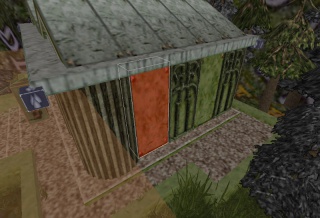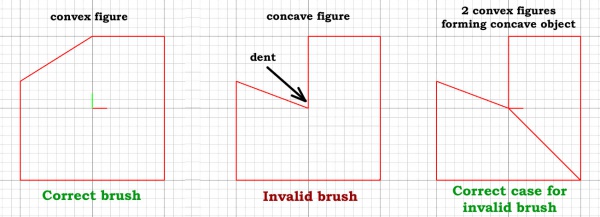Brush
m |
m |
||
| Line 2: | Line 2: | ||
[[File:Radiant brush.jpg|320px|right|thumb|Brush of the crypt entrance in NetRadiant]] | [[File:Radiant brush.jpg|320px|right|thumb|Brush of the crypt entrance in NetRadiant]] | ||
| − | Basic building block in a level. It is used primarily to define the physical structure of the area being designed. The term brush is used by Radiant to refer to anything that is not an entity, and therefore also encompasses [[ | + | Basic building block in a level. It is used primarily to define the physical structure of the area being designed. The term brush is used by Radiant to refer to anything that is not an entity, and therefore also encompasses [[patch mesh|patch meshes]]. A brush can be made to represent anything from solid matter (metal, dirt, wood, etc.) to liquids (lava, water, etc) depending on the textures and materials applied to them. |
| − | Brush is [[CSG | consecutive solid geometry]]. It defines a form made of it's sides and a volume which is anyting inside. Brush is using this rules: | + | === Shape === |
| + | |||
| + | Brush is [[CSG|consecutive solid geometry]]. It defines a form made of it's sides and a volume which is anyting inside. Brush is using this rules: | ||
* Minimum 3 sides | * Minimum 3 sides | ||
| Line 10: | Line 12: | ||
* If slice brush by the plane of any of it's sides, whole brush will be on one side of the plane | * If slice brush by the plane of any of it's sides, whole brush will be on one side of the plane | ||
| − | === | + | {{Important|If modifying brush shape, all this rules should be followed. Radiant have tools to move/transform brush vertexes, sides and planes. If you apply transformation that will lead to CSG rules breakage, resulting brush will become invalid. For most cases Radiant do not allow you to do that.}} |
| + | |||
| + | [[File:Brush rules.jpg|600px]] | ||
| + | |||
| + | === Texturing === | ||
Since brush internal structure dont have vertices, it is using special projection technique to get texture mapping: | Since brush internal structure dont have vertices, it is using special projection technique to get texture mapping: | ||
| Line 33: | Line 39: | ||
* Can modify brush in various ways with no texture breakage (make wall longer for example). | * Can modify brush in various ways with no texture breakage (make wall longer for example). | ||
| − | == | + | === Volume === |
| − | === | + | ==== Brush contents ==== |
Physics-related contents of the brush. Could be one of the followed: | Physics-related contents of the brush. Could be one of the followed: | ||
| Line 48: | Line 54: | ||
Brush contents are defined from the materials brush have on it's sides. Usually all brush sides must have same contents (mixed contents will give a compiler warning and could lead to bugged behavior). | Brush contents are defined from the materials brush have on it's sides. Usually all brush sides must have same contents (mixed contents will give a compiler warning and could lead to bugged behavior). | ||
| − | === | + | ==== VIS transparency ==== |
This is not real transparency but any brush that does not provide structure/seal to a room, and merely is there to detail the room. | This is not real transparency but any brush that does not provide structure/seal to a room, and merely is there to detail the room. | ||
Revision as of 16:06, 8 October 2012
Basic building block in a level. It is used primarily to define the physical structure of the area being designed. The term brush is used by Radiant to refer to anything that is not an entity, and therefore also encompasses patch meshes. A brush can be made to represent anything from solid matter (metal, dirt, wood, etc.) to liquids (lava, water, etc) depending on the textures and materials applied to them.
Shape
Brush is consecutive solid geometry. It defines a form made of it's sides and a volume which is anyting inside. Brush is using this rules:
- Minimum 3 sides
- Each side is plane forming polyhedron (maximum 16-24 corners)
- If slice brush by the plane of any of it's sides, whole brush will be on one side of the plane
Texturing
Since brush internal structure dont have vertices, it is using special projection technique to get texture mapping:
- Texture get projected from axis planes (XY, XZ, YZ) to a sides of the brush, optimal projection plane is selected by brush side orientation.
- Texture is rotated by plane's rotate parameter.
- Texture position is scaled by plane's stretch (x and y).
- Texture position is shifted by plane's offset (x and y).
- Using texture dimensions, positions is converted to texture coordinates.
This leads to a number of limitations applied for brushes:
- Rotating texture is tricky as no rotation origin is specified, this leads to texture breakage when brush is rotated to small angles (90 degrees rotation work fine)
- Texturing may broke if texture resolution is changed (there is material trick to bypass that)
Along with limitations, there is a number of benefits:
- No texture coords = no UVW unwrap work.
- A little easier to control texture detail.
- No texture UV breakage when model is sliced/expanded.
- Can scale model with keeping original texture detail.
- Can modify brush in various ways with no texture breakage (make wall longer for example).
Volume
Brush contents
Physics-related contents of the brush. Could be one of the followed:
- Solid
- Non-solid
- Water
- Slime
- Lava
- Sky
Brush contents are defined from the materials brush have on it's sides. Usually all brush sides must have same contents (mixed contents will give a compiler warning and could lead to bugged behavior).
VIS transparency
This is not real transparency but any brush that does not provide structure/seal to a room, and merely is there to detail the room.
Detail brushes (Radiant feature) and bmodels are always 'transparent'.
Also if brush have sides which is marked detailed or transparent, it will be forced transparent.

